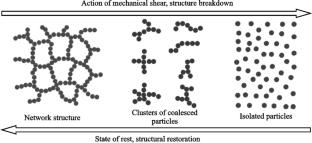Generalized Method for Normalizing the Degree of Thixotropy/Rheopexy to Evaluate the Structure of Powder Suspensions
Abstract
The structure of suspensions used to apply films by colloidal methods determines their key properties: thickness, surface roughness, and density. Direct structural studies of thin suspensions are significantly complicated, especially when the task is to determine changes in the structure induced by mechanical loads present in the film development process. This problem can be addressed through rheological studies. For this purpose, a method for normalizing the degree of thixotropy/rheopexy was devised to serve as a quantitative parameter for evaluating the structure of fluids based on their rheological properties. The trapezoidal integration method for calculating the flow curve area was demonstrated. The developed normalization method relies on a modified standard score equation that accommodates the peculiarities of flow curves. The normalized degree of thixotropy/rheopexy was employed to assess the structures of suspensions with identical compositions but subjected to varying maximum shear rates (200, 500, and 800 sec–1) to plot the flow curves. The nonnormalized degrees of thixotropy for these suspensions differed by 11 to 12 times. The developed parameter allowed the deviation to be reduced to 16–19%. The normalized degree of thixotropy/rheopexy, along with the flow behavior index and effective viscosity, was used for the indirect evaluation of structural changes in suspensions with higher nanopowder content based on the rheological properties. This approach enabled the identification of four structural states of suspensions: isolated agglomerates, enlargement of the agglomerates accompanied by rheopectic flow, transition to Newtonian flow after the agglomerates deformed in the flow direction, and evolution of a regular network structure signified by thixotropic flow.


 求助内容:
求助内容: 应助结果提醒方式:
应助结果提醒方式:


